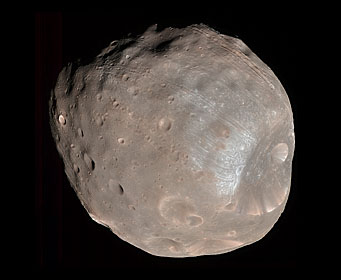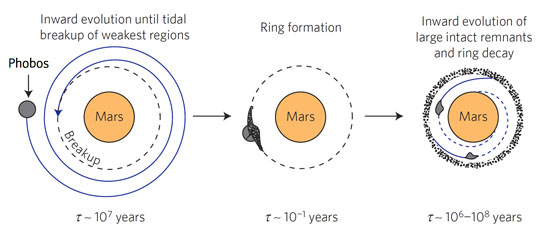Will Phobos Create a Ring Around Mars?
Dynamicists predict that the larger of Mars's two moons will shatter to create a ring, slam into the planet — or both — in 20 to 40 million years.
The Red Planet's two moons, discovered by Asaph Hall in 1877, are small and irregularly shaped. Deimos circles every 30.3 hours from an orbit that averages 20,100 km high. Larger Phobos, only 27 km (17 miles) long, orbits just 5,980 km (3,710 miles) above the Martian surface. In fact, Phobos hovers closer to its planet than any other moon in the solar system. That's not a good thing.

NASA's Mars Reconnaissance Orbiter captured this view of the Martian moon Phobos on March 23, 2008, from a distance of about 4,200 miles. It's actually a false-color view, combining data from the camera's blue-green, red, and near-infrared channels.The smallest resolved features are about 65 feet across.
NASA / JPL / Univ. or Arizona
NASA / JPL / Univ. or Arizona
Because it whips around in just 7.7 hours, compared to the 24.7 hours that Mars takes to rotate, Phobos is doomed. Thanks to a teensy tidal interaction that its gravity creates in the Martian interior, this moon is slowly losing orbital energy and moving ever-so-slowly closer to the planet. Dynamicists predict that it should drop into the Martian atmosphere in perhaps 20 to 40 million years .
Arguably, Phobos should have performed its death dive long ago. But its small size minimizes the tidal torquing inside Mars, and it likely started out just inside the altitude (20,500 km) that would have synched its orbital period with the planet's spin rate. So it's taken 4½ billion years for Phobos to migrate this far inward.
As it gets closer to Mars, the tidal forces that are inexorably building within Phobos will start to tear it apart — and maybe they already are. Earlier this month, at the American Astronomical Society's Division for Planetary Sciences meeting, Terry Hurford (NASA Goddard) presented a new analysis of the numerous grooves found in the surface of Phobos. When the Viking orbiters first imaged these in 1976, geologists assumed they were fractures radiating from Stickney, a 10-km-wide pit that takes up a sixth of the moon's circumference.
But, as Hurford and his collaborators point out, the fractures are actually mostly symmetric to the point on Phobos directly facing toward Mars. The implication is that The End has already begun. "We think that Phobos has already started to fail," Hurford says, as the moon is gradually distorted into an oblong shape. "And the first sign of this failure is the production of these grooves."

Hundreds of grooves crisscross the surace of Phobos, as this map portrayal shows. Some might be related to the formation of the large crater Stickney, but researchers now suspect most of them are signaling that the little moon's interior is starting to break apart due to tidal interactions with Mars.
USGS / P. Stooke
USGS / P. Stooke
Right now the tidal forces exerted by Mars are too weak to be cracking Phobos open if its interior is solid throughout, which is how planetary scientists once envisioned this fast-moving moon. But the thinking these days is that Phobos is a big pile of rubble masked by a veneer of fine dust perhaps 100 meters thick. What's the evidence for that? The Stickney impact would have shattered a solid object, so the interior must have been at least partly fragmented when it endured that big whack. Also, the spectrum of Phobos is a dead ringer for that of the Tagish Lake meteorite, a porous carbonaceous chondrite that fell onto a frozen lake in 2000.
To Hurford and his team, all this suggests that the many grooves are akin to stretch marks created as the interior shifts around and fractures. Curiously, the pattern of grooves on the moon's northern half provides a remarkable fit to the stress calculations, yet the southern half has grooves oriented much more randomly. Some grooves appear fresher than others, implying that the tidal deconstruction of Phobos is going on now.
Yet To Come: A Ring Around Mars?
The timetable for Phobos' demise depends critically on how much of a tide its gravity is creating inside Mars, and estimates for that vary. If the Martian interior is relatively "squishy," yielding stronger tides, then Phobos has at most 25 million years before its ultimate plunge. A stiffer Mars, which some researchers support, might give the moon another 70 million years.
Regardless, bad things will happen to Phobos once its orbit drops too close to the Martian surface. Exactly what will take place and when depends on the moon's interior structure, and researchers Benjamin A. Black and Tushar Mittal (University of California, Berkeley) examine the possible outcomes in the November 21st issue of Nature Geoscience.
They conclude that Phobos won't simply plunge intact into Mars. Instead, it's more likely that the moon's dusty, outer layer will stripped away first, creating a temporary ring around Mars very quickly — in just a week or so.

Once Phobos comes close enough to Mars, the planet's gravity will create tides in the moon's interior strong enough to tear it apart. One possible outcome is that the moon's outer layers will be drawn away first, rapidly creating a ring around Mars that could last for tens of millions of years.
Nature Geoscience / B. Black & T. Mittal
Nature Geoscience / B. Black & T. Mittal
Depending on how much mass it sucks away from the moon, the ring might initially rival Saturn's in its particle density — but Saturn's will likely still appear brighter because its ring consists of icy bits whereas particles in a Phobos-derived ring would be nearly black. In any case, Black and Mittal calculate that, once formed, the ring could linger for anywhere from 1 to 100 million years.
Meanwhile, the solid chunks of Phobos will meet a quicker end. They'll strike the surface, creating a series of oblique craters around the planet's equator. If big pieces break apart while plunging through the atmosphere, they could strafe the surface and create chains of craters sorted in size by the fragments' masses. Then that beautiful but ephemeral ring will be all that remains of Phobos, and Deimos (out of danger thanks to its higher orbit) will become Mars' lone moon.
No comments:
Post a Comment